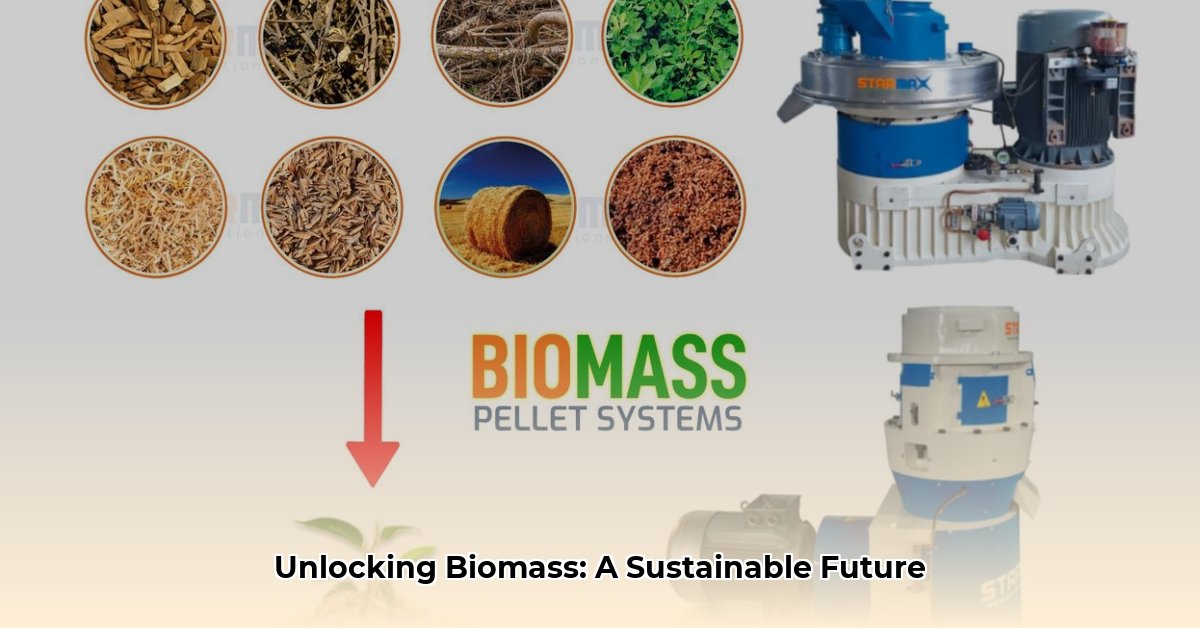Imagine powering our world with plants – not just any plants, but the organic materials we often discard: crop residues, wood scraps, even fast-growing grasses. This is the potential of biomass processing: transforming organic matter into valuable energy, fuels, and bioproducts. This comprehensive guide explores the diverse world of biomass processing, from the feedstocks used to the technologies employed, and analyzes its benefits and challenges in the context of a sustainable future.
Decoding Biomass: Nature’s Energy Reserve
Biomass is essentially stored solar energy. Through photosynthesis, plants capture sunlight and convert it into chemical energy, stored within their leaves, stems, and roots. This stored energy, locked within organic matter, is what we call biomass. Unlike fossil fuels, which are finite and take millennia to form, biomass is a renewable resource, offering a more sustainable path towards meeting our energy demands.
Biomass sources are surprisingly diverse. Forests provide wood and wood processing residues, while agriculture offers crop residues like corn stalks and dedicated energy crops like switchgrass. Even urban environments contribute through municipal solid waste, presenting an opportunity to transform trash into treasure. Algae, with its rapid growth and minimal land requirements, also holds significant promise as a future biofuel source.
Several methods exist for extracting this stored energy and converting it into usable forms. Direct combustion, the simplest approach, involves burning biomass to generate heat or electricity. Thermochemical processes, such as pyrolysis and gasification, use heat and controlled oxygen or steam levels to decompose biomass into bio-oil, syngas, and biochar. Chemical processes like transesterification convert oils and fats into biodiesel. Finally, biological methods like fermentation and anaerobic digestion utilize microorganisms to produce biofuels like ethanol and biogas. The choice of conversion method depends on the type of biomass and the desired end product.
The applications of biomass energy are far-reaching. Biofuels can power vehicles, biopower can generate electricity, and biochemicals can serve as building blocks for bioplastics and other sustainable products. Biochar can enrich soil and sequester carbon, while biogas can be used for heating and cooking.
While biomass offers numerous advantages, including renewability, potential carbon neutrality, and waste reduction, it also faces challenges. Sustainable harvesting practices are crucial to prevent deforestation and soil erosion. Competition with food crops for land and the potential for air pollution from inefficient burning are also important considerations. Ongoing research seeks to optimize the entire biomass energy lifecycle, from cultivation to conversion and utilization, to minimize environmental impacts and maximize benefits.
Feedstocks: Fueling the Biomass Revolution
Biomass feedstocks, the raw materials of bioenergy, come from a variety of sources.
Purpose-Grown Energy Crops:
Dedicated energy crops, like switchgrass, miscanthus, and energy cane, are fast-growing, high-yielding plants often cultivated on marginal lands unsuitable for food crops. This dual benefit avoids competition for valuable farmland while providing a dedicated renewable energy source.
Agricultural Residues:
The leftovers from farming—stalks, leaves, husks, and straw—can be collected and processed for bioenergy, offering farmers an additional income stream and reducing agricultural waste.
Forestry Residues:
Branches, bark, wood chips, and other woody materials left over from logging and forest management practices serve as valuable feedstocks, promoting forest health and resource efficiency.
Algae: Tiny Plants, Big Potential:
Algae, with its rapid growth, minimal land requirements, and ability to thrive in wastewater, presents a significant opportunity for biofuel production, although challenges in cultivation and processing remain.
Wood Processing Byproducts:
Sawdust, bark, and wood chips from the wood processing industry are valuable feedstocks, minimizing waste and maximizing resource utilization.
Municipal Solid Waste (MSW):
The organic portion of municipal solid waste—yard trimmings, food scraps, and paper—can be diverted from landfills and converted into bioenergy, reducing landfill burden and extracting value from discarded materials.
Wet Waste: A Challenge and an Opportunity:
Wet waste, including food waste, biosolids, and industrial organic waste, poses processing challenges due to its high moisture content, but also represents a substantial potential source for resource recovery.
The key to efficient biomass processing lies in matching the right feedstock to the appropriate conversion technology. Mechanical, thermal, chemical, and biological methods each have their strengths and weaknesses, and selecting the optimal technology depends on the feedstock’s characteristics and the desired end product. Efficient logistics, including harvesting, collection, storage, transportation, and handling, are crucial for cost-effective bioenergy production. Research into the feedstock-conversion interface aims to improve the efficiency and reliability of biorefineries.
Processing Technologies: Unlocking Biomass Energy
Several technologies convert biomass into usable energy.
Direct Combustion:
The simplest method, direct combustion involves burning biomass to generate heat for direct use or electricity generation via steam turbines. This is a well-established technique, particularly suitable for readily available feedstocks like wood.
Thermochemical Conversion:
These methods use heat and controlled oxygen levels to decompose biomass.
-
Pyrolysis: Heating biomass with minimal oxygen produces biochar, bio-oil, and syngas. Biochar can enrich soil, bio-oil can be refined into fuels, and syngas can be burned or converted into liquid biofuels.
-
Gasification: Heating biomass with controlled oxygen or steam produces primarily syngas, a versatile fuel for electricity generation, heat production, or conversion into liquid biofuels.
-
Torrefaction: This mild heat treatment improves biomass properties for combustion, making it more similar to coal and enhancing its handling and storage characteristics.
-
Hydrothermal Carbonization (HTC): This process uses water and heat to convert wet biomass into hydrochar, a coal-like substance with a higher energy density, suitable for fuel or soil amendment.
Chemical Conversion:
- Transesterification: This process transforms vegetable oils and animal fats into biodiesel, a cleaner-burning fuel for diesel engines.
Biological Conversion:
These methods utilize microorganisms to break down biomass.
-
Anaerobic Digestion: In an oxygen-free environment, bacteria digest organic matter, producing biogas (primarily methane), which can be used for heating, cooking, or electricity generation. This method is particularly effective for managing organic waste.
-
Fermentation: This process uses yeast to convert sugars into ethanol, a biofuel that can be blended with gasoline or used in specialized engines.
Ongoing research explores advanced biofuels, including algae-based fuels and more efficient conversion methods. The future of biomass processing holds the potential to transform waste streams into valuable resources, contributing to a more sustainable world.
Benefits and Challenges: Weighing the Scales
Biomass processing offers significant advantages but also poses challenges.
Advantages:
-
Renewability and Sustainability: Biomass is a replenishable resource, offering a more sustainable alternative to fossil fuels when harvested responsibly.
-
Potential Carbon Neutrality: Sustainable biomass processing can be potentially carbon neutral, as the CO2 released during combustion is offset by the CO2 absorbed during plant growth. However, this depends on sustainable practices and the specific processing methods employed. Ongoing research and life cycle analyses are crucial for accurately assessing the carbon footprint of different biomass pathways.
-
Waste Reduction and Resource Utilization: Biomass processing can utilize organic waste streams, reducing landfill burden and promoting a circular economy.
-
Enhanced Energy Security: Biomass can diversify energy sources, reducing reliance on imported fossil fuels and enhancing national energy security.
Challenges:
-
Environmental Impacts (Conditional): Unsustainable harvesting practices can lead to deforestation, habitat loss, and soil degradation, negating the potential carbon benefits. Careful land management and sustainable harvesting practices are essential for minimizing environmental impact. Life cycle assessments are crucial for evaluating the overall environmental performance of biomass processing pathways.
-
Lower Energy Density: Biomass generally has a lower energy density compared to fossil fuels, requiring larger volumes for equivalent energy output. Research focuses on improving energy conversion efficiency to address this challenge.
-
Scalability and Land Use Competition: Scaling up biomass production to meet substantial energy demands can compete with land for food production. Strategic land use planning and exploration of alternative feedstocks like algae are essential for mitigating this challenge.
-
Economic Viability: The economic viability of biomass processing depends on feedstock costs, transportation logistics, processing technologies, and energy market prices. Continued technological advancements and policy support are essential for improving cost-competitiveness.
The Future of Biomass: Innovation and Sustainability
The field of biomass processing is constantly evolving. Researchers are exploring innovative technologies, such as advanced biorefineries, to optimize efficiency and minimize environmental impacts. The development of novel bio-based materials and strategies for carbon capture and storage further expand the potential of biomass. While the future holds uncertainties, biomass processing promises to play a pivotal role in our transition to a cleaner, greener, and more sustainable future. Continued research, responsible implementation, and open dialogue are crucial to ensure that biomass fulfills its promise as an environmentally sound and sustainable energy solution.
- Wind Turbine Generator Kit For Home: Is One Right For You? - November 2, 2025
- Wind Turbine Fire: Questions About Safety Spark Debate - October 31, 2025
- Vertical Axis Wind Turbine Design: Improving Efficiency and Overcoming Limits - October 29, 2025
















